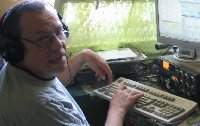|
Info
|
|
|
| U T C |
| HISTORY
How
I became a HAM
Early
years
I, from my childhood, have ever liked to
listen to radio plays and cabarets broadcasted mainly
late evening. One of my schoolmates - in the primary
school more than 5 decades ago - once mentioned that a
radio receiver could be constructed of a few
components at home. Since our family broadcast
receiver was switched off by bedtime at 8 pm I felt my
time was to come. Well, to be a stealth listener of the
forbidden fruit I drew up a project to build a crystal
receiver with headphones hidden underneath my pillow.
So I started collecting information on "how to" as
well as parts available. But alas! The detector and
the high impedance headphones were not available in
regular shops so I looked around in the secondhand
markets and finally got a galena crystal and a WWII headphones. I have to remark that solidstate diodes
were not available at that time. We heard about such
things, maybe in the fairy tales. The antenna
problem was passed-by hiding long wire, as long as it
could be, behind furniture all around in our downtown
flat. Water tap served as grounding.  Just some efforts and the radio sounded after all so the local broadcast could be copied sometimes well, sometimes poor. Meanwhile I was presented with my first technical book titled " Transistor A bit later the first transistors could
be available. Meanwhile I madly bought all periodicals
and books about the art of radio techniques. Still
attending the elementary school I had not knowledge
enough to understand and use mathematics formulas for
the calculations needed e.g. to design a coil. I
already knew the squaring process but had no idea
about extracting a root. So I calculated by means of
iteration fretting numberless of pencils. No
electronic calculators existed yet and slide rule was
still far away for me, needles to say. To tell the
truth I had no tools and soldering iron until then. The next step was to collect those
gadgets and to learn to use them. It took a while, of
course. More and more periodicals and books got piled
up on my bookshelves and I sank into them. So it came
from that I decided to go on studying in an electrical
technical high school to understand the radio and
electricity. Years later I graduated as qualified
electrical technician What a broadcast receiver knows Our family broadcast receiver, born in a local factory in the mid of '50s, was a classical type, a 3+1 tube system for middle and shortwave. When you test the reception capability of a crystal receiver you have to resemble and identify stations received with using a sensitive broadcast receiver. So I started tuning ours so discovering the middle waves. The next step was to attempt high frequency reception with my crystal rx but due to the poor antenna I failed. But I was on HF by the bc rx and what a wonder! Great number of stations could be heard round the clock. I attempted to identify them though the language barrier was a problem. Finally I got to a fair level to recognize the language I heard. The next step led to the map to find the location of the stations heard. So I think I got to be prepared fairly for the future to become a ham. And so on... To be continued...
|
| LINKS
HAMLOG - log search You have to log in to use or search. My log does not contain recent contest QSOs. SPAR Society for the Preservation of Amateur Radio is an international group activity to preserve ham radio for the future. Haros Radio Club The Club where I belong to (Hungarian mainly). HAmatőr Forum The most popular Hungarian ham forum for the time being (Hungarian) Contest Calendar (weekly) Actual contest information week by week. IARU The International Amateur Radio Union - The world organization of the amateur radio representation as ITU consultant. Hobby Rádió Online retro rádió, rádióamatőr témák is (Hungarian). |
CTC # 761 GACW # 802 CDX Member of SPAR